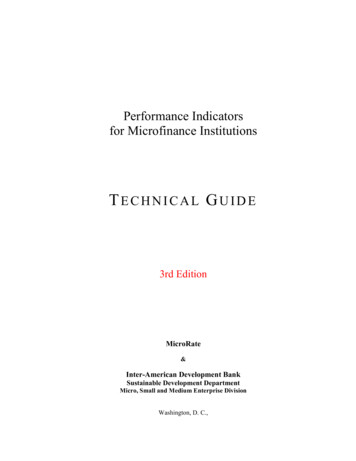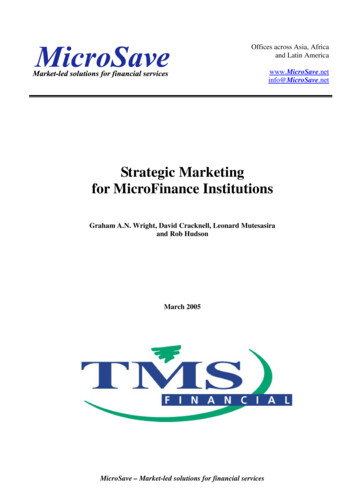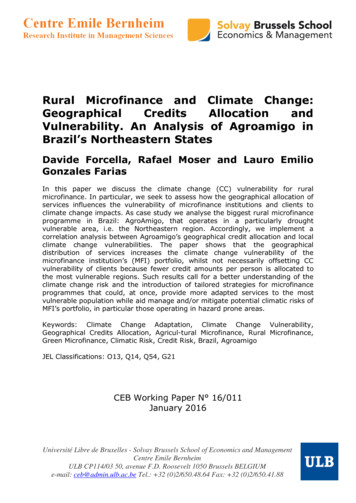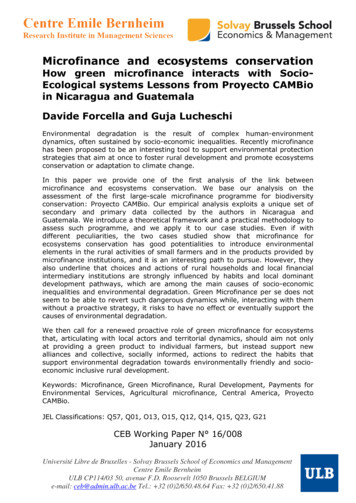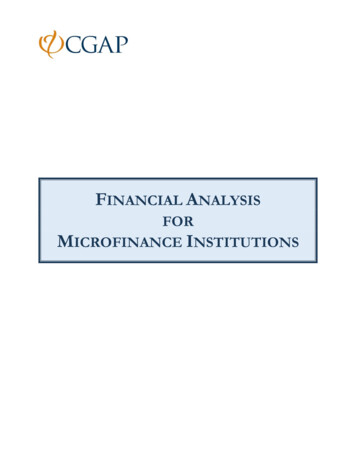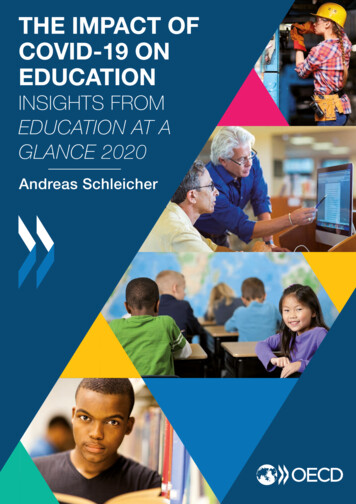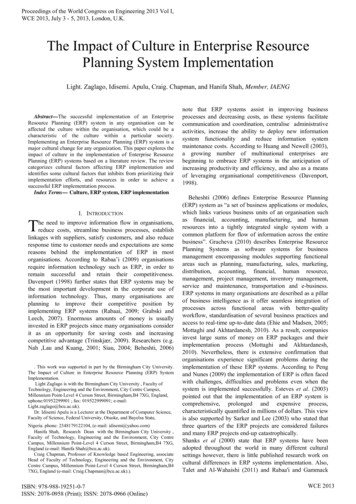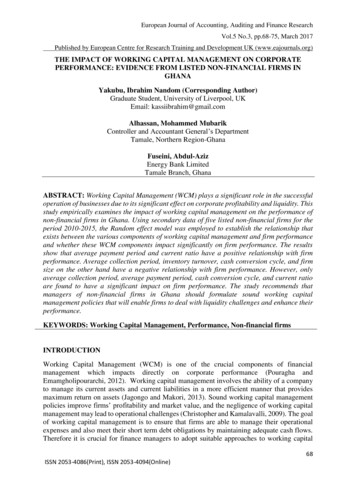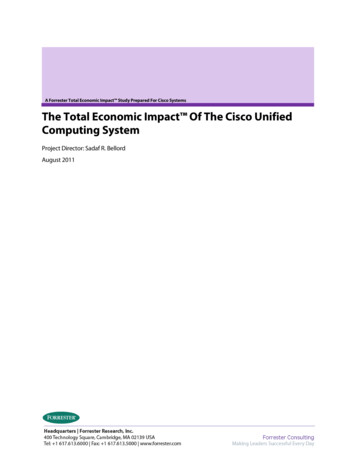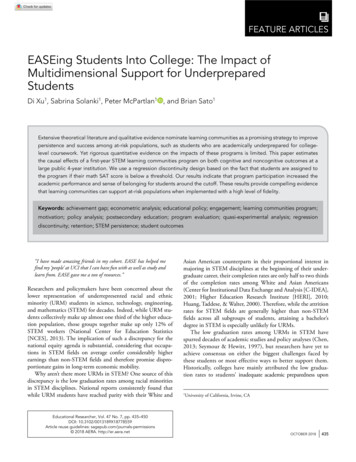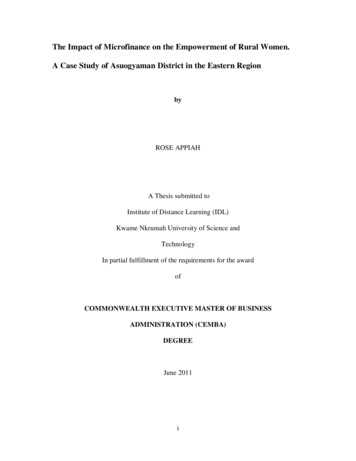
Transcription
The Impact of Microfinance on the Empowerment of Rural Women.A Case Study of Asuogyaman District in the Eastern RegionbyROSE APPIAHA Thesis submitted toInstitute of Distance Learning (IDL)Kwame Nkrumah University of Science andTechnologyIn partial fulfillment of the requirements for the awardofCOMMONWEALTH EXECUTIVE MASTER OF BUSINESSADMINISTRATION (CEMBA)DEGREEJune 2011i
DECLARATIONI hereby declare that this submission is my own work towards the CEMBA and that to thebest of my knowledge, it contains no material previously published by another person normaterial which has been accepted for the award of any other Degree of the University,except where due acknowledgement has been made in the text.Rose Appiah . . (PG3040609). . SignatureDateCertified byMr. Gordon Newlove Asamoah . (Supervisor)Signature . DateCertified by . . . (Head of Department)Signatureii . . Date
DEDICATIONThis work is dedicated to the Almighty God for His guidance and protection throughoutmy academic life.It is also dedicated to my dear husband, Mr. Joseph Kofi Okyere and my two lovely kids,Oheneba and Nhyira.iii
ACKNOWLEDGEMENTSI would like to first and foremost give thanks to the Almighty God for His protection andguidance throughout the CEMBA programme.My husband, (Joseph Kofi Okyere) for his immense support throughout this programme,Mrs. Theresa Osei Koffi of KNUST (IDL) and my twin sister and husband (Mr. & Mrs.Kumah) also deserve commendation. To all my siblings especially Mr. Pee and Managerfor their support.My heartfelt thanks go to Mr.& Mrs. Dzordzorme of V.R.A Akosombo, my cousin andhusband (Mr. and Mrs. Nimako of East Legon) and to all my mates and friends atKNUST especially Connie, Esther and Marjorine and also to Miss Naa Afi Mante andMr. Christopher Blay of V.L.T.C Akosombo for their support during the programme.My sincere appreciation goes to my supervisor, Mr. Gordon Newlove Asamoah forsupervising this work; your time and insightful review is a critical success factor of thiswork.May the good Lord richly bless you all for being part of this success.iv
ABSTRACTThe main objective of microfinance scheme or programme is to provide opportunity forthe poor to access financial services in order to engage in income generating activities.This as it were, would lead to economic empowerment of the poor women who aredeprived of the paid jobs.However, there has been a debate in recent times on whether these MFIs really providethe opportunity for women who forms majority of the poor all over the world to assessfinancial services thereby improving their welfare.The study therefore sought to assess whether products of MFIs have really contributed tothe growth or otherwise of women entrepreneurs thereby empowering themeconomically. Simple random sampling techniques were employed in selecting thesample. The main research instruments used in the study were structured questionnaireand interview.The study revealed that even though MFIs have to some extent empowered rural womeneconomically, its full benefit is yet to be realized by these women due to its high interestrate, inflexible payment schedule, group formation etc.It is therefore recommended that the interest rate should be reduced and be made knownto the customers. And to make repayment flexible it is recommended that repayment bemade in such a way that trusted members are given a payment per month instead of thetwo weeks payment. Again MFIs should continue to organize training programme for thewomen entrepreneurs. They should also embark on educational programmes onmicrofinance product. This would offer the client the opportunity to be familiar with theoperations of MFIs.v
TABLE OF CONTENTSPAGEDeclaration e of contentsviList of figures/List of TablesixList of AbbreviationsxCHAPTER ONE: GENERAL INTRODUCTION1.0 Background to the study11.1 Statement of the Problem41.2 Objectives of the Study51.3 Research Questions51.4 Justification of the Study61.5 Research Methodology61.6 Organisation of study71.7 Limitations of the study7CHAPTER TWO: LITERATURE REVIEW2.1 Introduction82.2 Policy Approaches to Women Empowerment122.3 Microfinance Definitions and Historical Background142.4 Impact of Microfinance on Women Empowerment192.5 The need for Microfinance Products to target Women Enterprise242.6 Microfinance in Ghana: The Evolution26vi
CHAPTER THREE: RESEARCH METHODOLOGY3.1 Introduction333.2 Study Area333.3 The Sample Size343.4 Target Population343.5 Sources of Data Collection343.6 Methods of data collection343.7 Pretesting353.8 Sampling Procedure353.9. Questionnaire Administration363.10 Data Handling36CHAPTER FOUR: DATA ANALYSIS, FINDINGS AND DISCUSSIONS4.0 Introduction374.1 Socio-Demographic characteristics of respondents374.1.1 Sex and Age374.1.2 Marital Status and Number of Children384.1.3 Educational Attainment and enterprise engaged in424.1.4 Number of years in the enterprise434.2 Microfinance Intervention Available to Small Scale Women Enterprise454.3 Specific Packages for Women Enterprises (Entrepreneurs)474.4 The impact of microfinance interventions on women empowerment50vii
CHAPTER FIVE:SUMMARYOF FINDINGS, CONCLUSION AND RECOMMENDATIONS5.1 Introduction555.2 Summary of Findings565.3 Discussion585.4 Conclusion605.5 Recommendation60References63Appendix 166viii
List of FiguresFigure 1 Number of years in the enterprise44List of TablesTable 1: Age of respondents38Table 2: Marital status of respondents40Table 3: Number of children42Table 4: The time respondents started accessing micro product46Table 5: Reasons for liking or not liking anything about the MFI48Table 6: Conditions attached to MFI products49Table 7: Illustration of Improvement in Household Welfare52ix
List of Abbreviations1. ASRB–Asuogyaman Rural Bank2. ARB – Anum Rural Bank3. HCCUA – Hydro Creddit Co-operative Union Association4. ADB – African Development Bank5. NTHC – National Trust Holding Company6. UNIFEM – United Nations Development Fund for Women7. MDGs – Millennium Development Goals8. PNDC – Provisional National Defense Council9. WID – Women in Development10. GAD - Gender and Development11. MFIs –Micro Finance Institutions12. MDGs-Millennium Development Goals13. GSS-Ghana Statistical Service14. UN –United Nations15. MTL - Mid-Term Loan16. BOG-Bank of Ghana17. UNDP –United Nations Development Programme18. NGOs-Non- Governmental Agencies19. ACCION –Americans for Community Co-operation in Other Nations20. UNFPA – United Nations Population Fund21. FINCA – Foundation for International Community Assistance22. ILO – International Labour Oganisation23. OECD - Organization for Economic Cooperation and Development24. RCBs – Rural and Community Banks25. RMFls- Diversity of Rural Microfinance Institutions26. NBFLs - Non-Bank Financial Institutions27. FINSSAP -Financial Sector Strategic Plan28. FNGOs - Financial Non-Governmental Organizations29. ROSCAS - Rotating Savings and Credit Associations30. RFSP - The Rural Financial Services Projectx
CHAPTER ONEGENERAL INTRODUCTION1.0 Background to the StudyIn Ghana, the concept of microfinance is not new because there has always been thetradition of people saving, taking small loans from individuals and groups within thecontext of self-help to start business or farming ventures. First credit union in Africa wasestablished in Northern Ghana in 1955 by the Canadian Catholic missionaries. However,the SUSU which is one of the microfinance schemes started in Nigeria and spread toGhana in the early 20th century. Microfinance has developed into its current state throughgovernmental policies and programmes. For instance provision of subsidized credit in the1950s, the establishment of African Development Bank (ADB) and the establishment ofrural and community Banks in the 1970s and 1980s as well as the promulgation ofPNDCL 328 in 1991 to allow the establishment of different categories of non-bankingfinancial institutions including savings and loans companies and credit unions (Asiama etal, 2007).Microfinance is the provision of financial services to low-income clients or solidaritylending groups including consumers and the self-employed, who traditionally lack accessto banking and and related services.(www.opportunity.org). It therefore encompasses theprovision of financial services and the management of small amount of money through arange of products and a system of intermediary functions that are targeted at low incomeclients. It includes loans, savings, insurance, transfer services and other financial productsand services. It is thus one of the critical financial tools for the poor. According toxi
Simanowitz et al, (2007) as cited in Asiamah et al (2007), microfinance is a key strategyin reaching the Millennium Development Goals (MDGs).The objectives of microfinance among others are that the poor, mostly women (becauseof their engagement in unpaid work) need access to productive resources with financialservices being a key resource. Micro finance can have significant impact on cross cuttingissues such as women empowerment thereby promoting gender equality. Microfinanceschemes usually lend small short term loans to very poor micro-entrepreneurs (very poormicro-entrepreneurs are women). Loan repayment is always guaranteed by groupmembers collectively and access to future credit or loans is contingent on successfulrepayment. Hence peer monitoring and the prospect of subsequent larger loans act asstrong incentive for repayment (Ray, 1998). According to the 2000 population andhousing census 80% of the working population is found in the private informal sector.The sector is characterized by women dominance and lack of access to credit from thetraditional banking institution due to the question of collateral security. Therefore theeffectiveness of any microfinance scheme or programme should be assessed based onhow it has been able to empower women economically, politically and socially.Increasing evidence shows that not only is women overrepresented among the poorestpeople but is also more likely than men to spend their incomes on the welfare of childrenand dependents. Therefore poverty reduction programmes which target women are likelyto be more effective. Empowering women is the second stated goals of microcreditsummit campaign. There is also the evidence of significant potential for microfinance toenable women to challenge and change gender inequalities at all levels. There is now thexii
growing need to rethink the current best practices to ensure that women have equal andpossibly preferential access to all types of financial services (Mayoux, 2006). Manymicrocredit programmes have targeted one of the most vulnerable group in societywomen who are in households which own little or no asset. By providing opportunity forself employment, many studies have concluded that these programmes have significantlyincreased women’s security, autonomy, self-confidence and status within theirhouseholds (Mayoux, 2006). Is this the case in Ghana? This study would therefore findanswers to various questions raised herein. It would in short find out the impact ofmicrofinance on rural women and if there is any special microfinance product for smallscale enterprises of women in the Asuogyaman District.Why Women? Women represent 70% of those living on less than 2 a day. Women suffer inequitably from the chronic effects of poor nutrition, insufficienthealthcare and limited educational opportunity. Women do 66% of the world’s work and receive only 10% of the pay. Women spend 90% of their income on their families, while men typically spendonly 35%. Women who contribute to family finances have greater decision-making power,resulting in better nutrition, health and education for their children. When familyneeds are met, women are more likely to invest in their communities.(www.opportunity.org)xiii
1.1 STATEMENT OF THE PROBLEMMicrocredit programs allow women to take a greater role in household decision making;to have greater access to financial and economic resources; to have greater socialnetworks and more bargaining power vis-à-vis their husbands; and to have greaterfreedom of mobility (Linda Mayoux 1997).Naila Kabeer defines women’s empowerment as the process by which those who havebeen denied the ability to make strategic life choices acquire such ability.The main objective of microfinance scheme or programme is to provide opportunity forthe poor to access financial services in order to engage in income generating activities.This as it were, would lead to economic empowerment of the poor women, according toMoser (1998) all over the world form majority of the poor because they are deprived ofthe paid jobs.Despite many international agreements affirming their human rights, women are stillmuch more likely than men to be poor and illiterate. Microfinance programmes have thepotential to initiate a series of virtuous spirals of economic empowerment, increasedwell-being of women and their families and a wider social and political empowerment(Mayoux, 2006). United Nations Development Fund for Women (UNIFEM) providescredit to women as a way of strengthening them economically and politically. Are thesexiv
women empowered socially, politically and economically as a result of microfinanceservices they have benefitted? These issues raise question as to whether the financialinstitutions and the various interventions provided by the government to empowerwomen in Ghana have had any significant impact. These deserve a scientificinvestigation so as to assess the impact of micro financing on women empowerment inGhana particularly those in the Asuogyaman District in the Eastern Region.1.2 Objectives of the StudyThe study generally attempts to find out the impact of micro financing on empowermentofwomen particularly those in the rural areas.Specific objectives1. To identify some of the microfinance products (facilities or interventions) and specificpackages available to small scale enterprises run by women in the rural areas.2. To find out the impact of microfinance interventions/packages on the enterprises runby women entrepreneurs.3. To examine the impact that microfinance interventions/packages for women have hadon the families of these women.1.3 Research Questions1. What are some of the microfinance products available to small scale enterprises run bywomen in the Asuogyaman District?2. What impact has those interventions had on the women entrepreneurs?3. What effect has microfinance interventions had on the families of these women?xv
1.4 Justification of the studyMicrofinance and gender issues inform geo-politics of today. Therefore any governmentor institution which ignores them does so at its own peril. As such the findings of thestudy may be tapped by policy makers and institutions especially those in themicrofinance services to develop policy framework which will take care of gender issuesin micro financing in Ghana. This study intends to be a pace setter for similar studies tobe embarked on in other rural areas of the nation. The information gathered can be usedto improve the lot of Ghanaian women who form 51.3 per cent of the total population of24.23 million according to the provisional figures of the 2010 population and housingcensus.1.5 Research MethodologyThe study used both survey and in-depth interview to gather primary data for the study.Simple random sampling was used to select respondents. The sample size was 150 andthe population of interest comprises all micro/medium women entrepreneurs. They mustengage in any form of economic activities for which they have accessed anymicrofinance products. The study area was limited to ten communities in AsuogyamanDistrict. This area was purposively selected due to the poor nature of the women in thesecommunities as a result of the construction of Akosombo dam that has deprived thepeople of their farmland thereby the women resorting to petty trading. The study focusedonly on the impact of microfinance on women empowerment. Statistical Package of theSocial Sciences (S.P.S.S) Microsoft programme was used to analyse the data.Descriptive statistics was applied to group the information for easy comparison to drawconclusion.xvi
1.6Limitation of the StudyFirst of all, most Ghanaian businesses are not transparent. It was therefore difficultinitially to get the required information but based on the assurance that theinformation given would not be disclosed to their competitors, they were willing toparticipate.Time constraint was another factor as a lot of time was used in search for the gatheredinformation as they were completely scattered.1.7 Organization of the studyThe study is divided into five (5) main chapters or components. Chapter one deals withthe introductory aspect of the study whilst chapter two is devoted to the reviewing ofrelevant literature. Chapter three attempts a presentation of the methods used in the study.The two remaining chapters-four and five highlight data presentation and analysis, anddiscussion of finding and recommendations respectively.xvii
CHAPTER TWOLITERATURE REVIEW2.1Introduction to MicrofinanceMicro finance encompasses the provision of financial services and the management ofsmall amount of money through a range of products and a system of intermediaryfunctions that are targeted at low income clients. It includes loans, savings, insurance,transfer services and other financial products and services. It thus consists primarily ofproviding financial services, including savings, microcredit, micro-insurance, microleasing and transfers in relatively small transactions designed to be accessible to microenterprises and low income households (Asiama et al 2007).Women have been taking for granted since prehistoric days to date. This is due toignorance which gives rise to a social structure that reinforces women’s subordinationand inequality. For instance, A1-Bizri (1995) quoted PLO leader Yasser Arafat as saying“The wombs of Palestinian women are bombs in the confrontation with the Israeli’s”.This demonstrates the extent to which women can be used as animals for social sacrifice.It is against this background that Beijing Declaration and platform for Action (1996)noted with concern that there were considerable differences in women’s and men’s accessto and opportunities to exert power over economic structures in their societies. In mostparts of the world, women are virtually absent from or are poorly represented ineconomic decision-making including the formulation of financial, monetary, commercialxviii
and other economic policies. Since it is often within the framework of such policies thatindividual men and women make their decisions, inter alia, on how to divide their timebetween remunerated and unremunerated work. The actual development of theseeconomic structures and policies has a direct impact on women’s and men’s access toeconomic resources, economic power and consequently the extent of equality betweenthem as the individual and the family level as well as in the society as a whole. Thedocument indicated as a critical area of concern the advancement of women and theachievement of equality between men and women are matters of human rights and acondition for social justice and must not be seen in isolation as a women’s issue. To thisend, governments, the international community and civil society, including nongovernmental organizations and the private sector are called upon to take strategic actionamong others in the following critical area of concern.There are insufficientmechanisms at all levels to promote the advancement of women.Gender differences are core in World Bank lending. They are relevant for povertyalleviation. Thus understanding the responsibilities and roles of women and men amongvarious income groups will help borrowers plan and implement effective developmentstrategies.Attention to gender issue
HCCUA – Hydro Creddit Co-operative Union Association 4. ADB – African Development Bank 5. . insurance, transfer services and other inancial products f and services. It is thus one of the critical financial tools for the poor. According to . . heal
